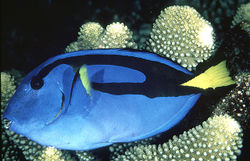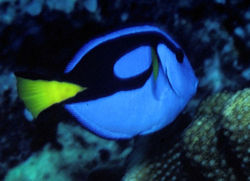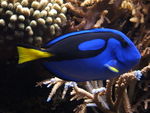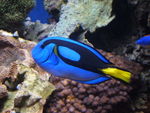Pacific regal blue tang
| Pacific regal blue tang |
|---|

|
| Scientific Classification |
|
| Binomial Name |
|
Paracanthurus hepatus |
| Image Description |
The Pacific Blue Tang is a member of the surgeonfishes and is one of the most active swimmers of the tangs. In captivity, they will need at least a 75 gallon tank (284 liters), preferably larger, to allow for adequate swimming space.
Body Design
Yellow and blue refer to the fish’s color, which changes as the fish matures. Young fish are bright yellow with blue spots near their eyes. As they mature, they become blue over most of their body with a yellow tail. Full-grown adults are a rich blue from head to tail, with narrow dark lines running the length of the body. http://www.nature.org/newsfeatures/specialfeatures/animals/fish/blue-tang.xml
Life Cycle
Males aggressively court female members of the school, leading to a quick upward spawning rush toward the surface of the water during which eggs and sperm are released. The eggs are small, approximately 0.8 mm in diameter. The eggs are pelagic(deep inside the sea), each containing a single droplet of oil for flotation. The fertilized eggs hatch in twenty-four hours, revealing small, translucent larvae with silvery abdomens and rudimentary caudal spines. Regal blue tangs can also, when faced with danger or dark spaces, make themselves semi-transparent, in order to help with evasion and light passivity, respectively.
Ecology
The species' range is common now . It can be found throughout the Indo-Pacific. It is seen in reefs of East Africa, Japan, Samoa, New Caledonia, and the Great Barrier Reef.[1] The regal blue tang is one of the most common and most popular marine aquarium fish all over the world. They live in pairs, or in a small groups of up to 10 or 12 individuals. These fish reach sexual maturity at 9–12 months of age.
The regal blue tang is ranked LC (least concern) by the World Conservation Union (IUCN), but is of low vulnerability. http://en.wikipedia.org/wiki/Paracanthurus
Importance to humans
The regal blue tang is of minor commercial fisheries importance, however, it is a bait fish. The flesh has a strong odor and is not highly prized. This fish may cause ciguatera(foodborne illness that create by the fish who live in tropical and subtropical waters.) poisoning if consumed by humans. Handling the tang risks the chances of being badly cut by the caudal spine. These spines, on both sides of the caudal peduncle, are extended from the body when the fish becomes excited. The quick, thrashing sideways motion of the tail can produce deep wounds that result in swelling and discoloration, posing a risk of infection. It is believed that some species of Acanthurus have venom glands while others do not. The spines are used only as a method of protection against aggressors
Video
The life of bluetang
References
http://en.wikipedia.org/wiki/Paracanthurus http://www.nature.org/newsfeatures/specialfeatures/animals/fish/blue-tang.xml




